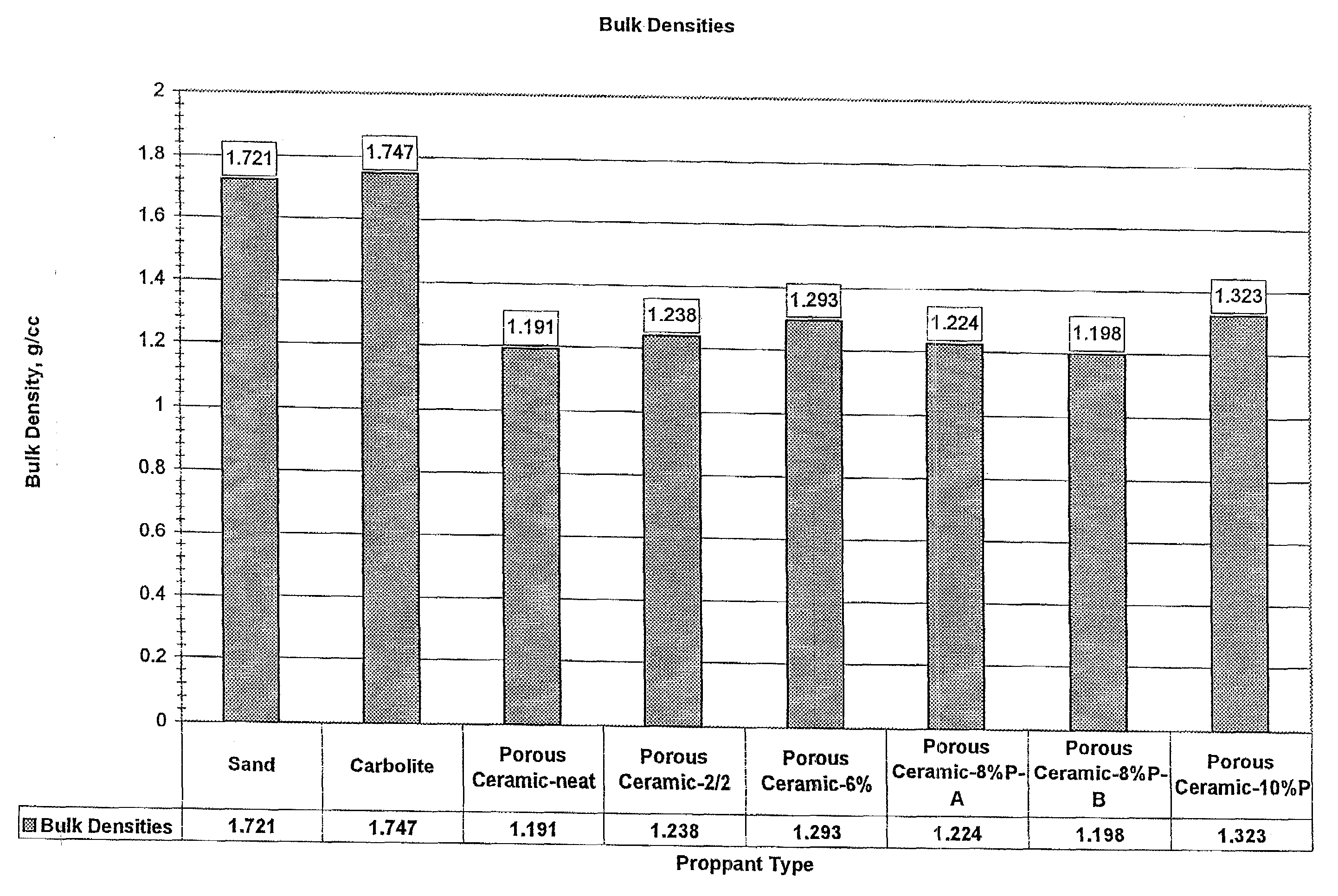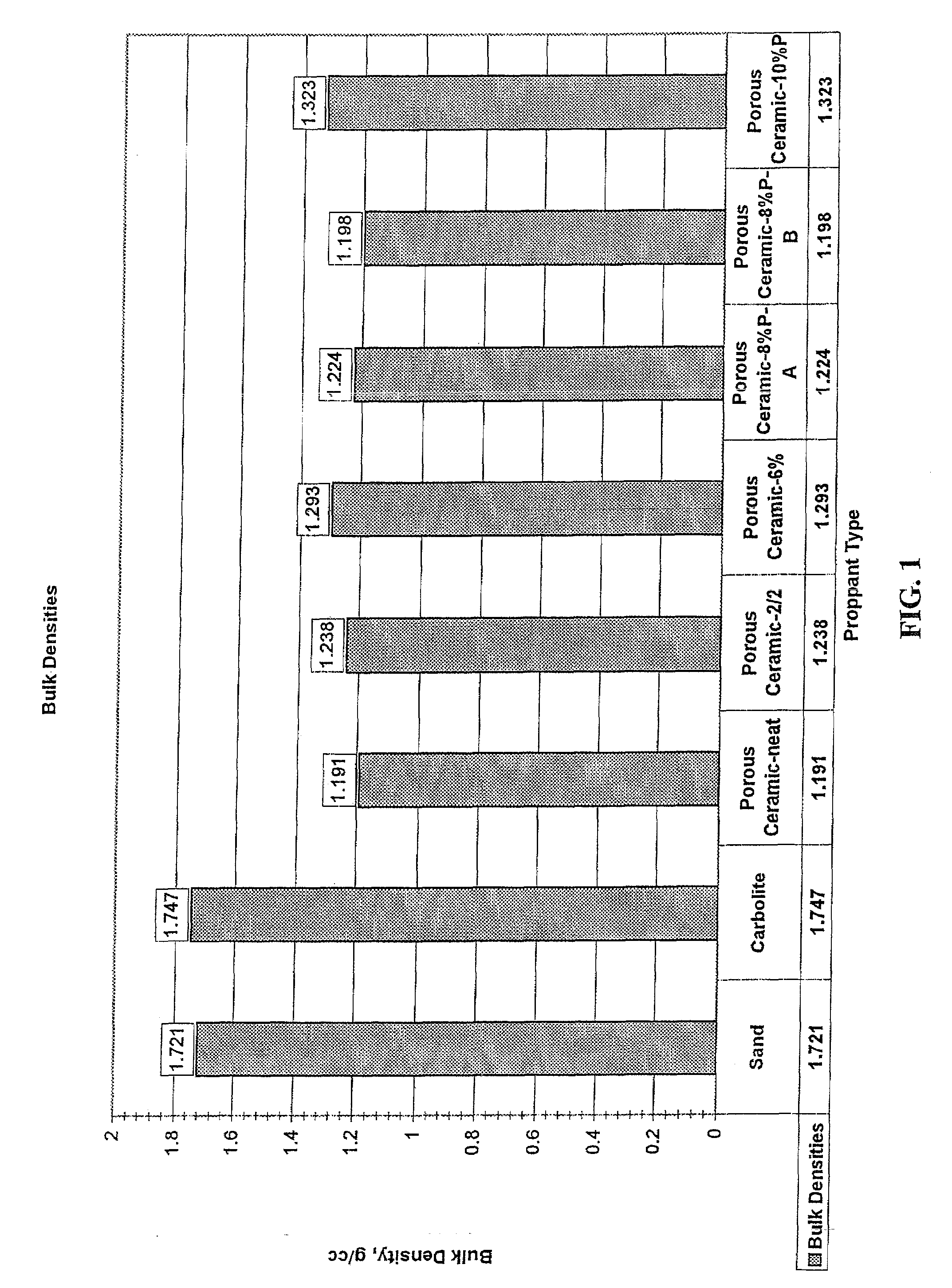Method of Fracturing Hydrocarbon-Bearing Formation With Coated Porous Polyolefin Particulate
a technology of porous polyolefin and hydrocarbon-bearing, which is applied in the direction of folding cabinets, thin material handling, borehole/well accessories, etc., can solve the problems of improper placement downhole, proppant pack and/or formation damage, and other problems, to achieve the effect of improving the overall system performan
- Summary
- Abstract
- Description
- Claims
- Application Information
AI Technical Summary
Benefits of technology
Problems solved by technology
Method used
Image
Examples
example 1
[0119]To obtain the data for this example, the following procedure was followed: Measured mass of 25 ml of sample on a graduate cylinder. Cylinder was tapped several times on the countertop and the volume adjusted to an even 25 ml prior to weighing. Mass / volume=bulk density.
[0120]The data of this example is shown in Table 1:
TABLE 1Bulk DensitiesSand1.721CarboLite1.747Porous Ceramic - Neat1.191Porous Ceramic - 2 / 21.238Porous Ceramic - 6%1.293Porous Ceramic - 8% P-A1.224Porous Ceramic - 8% P-B1.198Porous Ceramic - 10% P1.32
FIG. 1 illustrates comparisons of the bulk densities of various proppants / sand control materials to samples of a selected porous ceramic material (from Carbo Ceramics, Inc.).
[0121]In the examples, “Carbolite” is a commercial proppant available from Carbo Ceramics, Inc. “Neat” is untreated porous ceramic material from Carbo Ceramics, Inc., “2 / 2” is porous ceramic material from Carbo Ceramics, Inc. treated with 2% by weight of particle epoxy inner coating / penetrating ...
example 2
[0124]The porous particulate material employed was from “Carbo Ceramics” having a size of about 20 / 40 mesh. The particulate material was treated with various penetrating / coating materials corresponding to the same epoxy or phenol formaldehyde materials used above. The treated particulate material was tested alone, with no other particulate material blended in. Comparison materials include Jordan Sand, “Econoprop” proppant from Carbo Ceramics, “Econoflex” (coated Econoprop proppant), Hickory sand (Brady Sand), “PR6000” 2% coated Ottawa sand from BORDEN, and “Carbolite” proppant from Carbo Ceramics.
[0125]Conductivity tests were performed according to API RP 61 (1st Revision, Oct. 1, 1989) using an API conductivity cell with Ohio sandstone wafer side inserts. Each particulate material sample was loaded into the cell and closure stress applied to the particulate material using a “DAKE” hydraulic press having a “ROSEMOUNT” differential transducer (#3051C) and controlled by a “CAMILE” con...
example 3
[0129]Using the selected treated material of the Examples above, particles may be produced that are capable for use, such as having sufficient crush resistance for use or do not crush, under conditions of 2000 psi closure stress or greater, alternatively 2500 psi closure stress or greater, alternatively 3000 psi closure stress or greater, alternatively up to at least about 6000 psi closure stress, alternatively up to at least about 7000 psi closure stress, and alternatively at least about 8000 psi closure stress, i.e., almost as resistant to crush as commercial ceramic proppants which are heavier (e.g., commercial ceramic proppant (CarboLite) is about 40% heavier). In another embodiment, particles may be produced that are capable for use (e.g., have sufficient crush resistance for use or do not crush) under conditions of from about 2000 psi closure stress to about 8000 psi closure stress, alternatively from about 2500 psi closure stress to about 8000 psi closure stress, alternativel...
PUM
| Property | Measurement | Unit |
|---|---|---|
| particle densities | aaaaa | aaaaa |
| strength | aaaaa | aaaaa |
| specific gravity | aaaaa | aaaaa |
Abstract
Description
Claims
Application Information
 Login to View More
Login to View More - R&D
- Intellectual Property
- Life Sciences
- Materials
- Tech Scout
- Unparalleled Data Quality
- Higher Quality Content
- 60% Fewer Hallucinations
Browse by: Latest US Patents, China's latest patents, Technical Efficacy Thesaurus, Application Domain, Technology Topic, Popular Technical Reports.
© 2025 PatSnap. All rights reserved.Legal|Privacy policy|Modern Slavery Act Transparency Statement|Sitemap|About US| Contact US: help@patsnap.com



